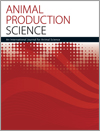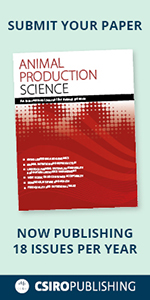
Animal Production Science
Volume 61 Number 1 2021
AN19493The performance of the Border Leicester in Australia
 , D. J. Brown, B. R. Cullis, A. K. Bell, T. J. May, M. W. Lollback, I. M. Rogan, I. D. Killeen, G. Caffery, L. R. Piper, B. M. Bindon, J. F. Wilkins and D. G. Fowler
, D. J. Brown, B. R. Cullis, A. K. Bell, T. J. May, M. W. Lollback, I. M. Rogan, I. D. Killeen, G. Caffery, L. R. Piper, B. M. Bindon, J. F. Wilkins and D. G. Fowler
Border Leicester performance in Australia was found to be problematic. Border Leicester improved animals, where selection was for improved reproduction coupled with a broadening of the breed’s genetic base, had a 19.3% advantage in the net reproductive rate over Border Leicesters, and were also superior when crossed with the Merino. Selection plus broadening the genetic base can help the Border Leicester to maintain its place in the Australian lamb industry.
Maternal environmental conditions encountered can permanently ‘program’ the developing fetus or embryo, resulting in disrupted growth and development in offspring during adult life. This is especially relevant in chicken meat production, as breeder hens are believed to be chronically stressed due to prolonged hunger, and this level of stress may ‘program’ their offspring to promote fat accumulation over muscle formation. Therefore, current chicken meat production strategies may unintentionally produce fatter chickens, an economically undesirable outcome.
Climatic conditions can impair pasture availability for the dairy cow when she requires it most. The present paper assesses the effect of reducing pasture allowance when such deficits occur, to determine how the animal adapts to the lower intake of nutrients. The results of the study showed that the cows adapt to such restrictions without interfering with the metabolic health of the animal, highlighting the importance of breeding the correct type of cow to cope with the potential constraints of a pasture-based system.
AN19448Tannin-rich forage as a methane mitigation strategy for cattle and the implications for rumen microbiota
 , Gabriela Benetel, Mateus M. Carriero, Ricardo L. M. Sousa, James P. Muir, Robert O. Macedo and Ives C. S. Bueno
, Gabriela Benetel, Mateus M. Carriero, Ricardo L. M. Sousa, James P. Muir, Robert O. Macedo and Ives C. S. Bueno
Methane from ruminant livestock contributes to global climate change. Rethinking ruminant feeding practices could involve natural alternatives for supporting animal production. Underexploited legume plants present numerous phenolic compounds that may reduce rumen methanogenesis. Our study revealed a positive relationship between condensed tannins in legumes species and Fibrobacter succinogenes. Condensed tannins provide a natural alternative to manipulate rumen microbiota and reduce bovine methane emissions.
The utilisation of oil palm industry by-products such as oil palm meal (OPM) would be economically advantageous because conventional feedstuffs are often expensive. Due to its high fibre and low protein content, OPM needs to be processed to increase the nutrient composition in term of OPM and urea pellet (PMUP) before being used as ruminant feed. Concentrate containing PMUP replacement for soybean meal could reduce feed costs with no effects on feed intake, nutrient utilisation, rumen fermentation or milk production in lactating dairy cows.
AN18708Performance of lactating buffaloes in pasture supplemented with palm-kernel cake

Concentrate supplementation, as well as the substitution of conventional concentrate ingredients with palm-kernel cake, was evaluated for lactating buffaloes during the dry period under pasture. Although concentrate supplementation did not increase milk production, it promoted an increase in the total solids in the milk, and in the production of energy-corrected milk. When corn and soybean meal were replaced with palm-kernel cake, there was a decrease in the intake of total digestible nutrients and, in particular, of crude protein and ether extract, but the total intake of dry matter did not decrease. However, milk production has decreased.
AN19611Animal welfare and biosecurity assessment: a comparison between Italian and Irish beef cattle rearing systems
 , Valentina Lorenzi, Giorgio Franceschini, Riccardo Compiani, Valeria Harper, Jessica Ginestreti, Giandomenico Ferrara, Carlo Angelo Sgoifo Rossi and Luigi Bertocchi
, Valentina Lorenzi, Giorgio Franceschini, Riccardo Compiani, Valeria Harper, Jessica Ginestreti, Giandomenico Ferrara, Carlo Angelo Sgoifo Rossi and Luigi Bertocchi
The Italian National Reference Centre for Animal Welfare (CReNBA) developed an on-farm welfare and biosecurity assessment protocol for beef cattle kept indoors, which consists of several indicators to be measured from animals, management practices, the farm environment and biosecurity plans. Despite intrinsic differences in beef production among countries, the protocol was successfully applied in Italy and in Ireland. The data collected revealed strengths and weaknesses of the rearing systems in both countries.
Supplementation of diets with essential oils and a Bacillus probiotic improved growth performance and immunity, and decreased diarrhoea of piglets, to the same extent as conventional antibiotics. The application of phytogenic compounds and probiotics thus represents as an alternative to in-feed antibiotic growth promoters.
AN18752 Abstract | AN18752 Full Text | AN18752PDF (300 KB) Open Access Article
The large inter-annual and decadal rainfall variability, which occurs in northern Australian rangelands, poses major challenges for the profitable and sustainable management of grazing businesses. A bio-economic evaluation found that when stocking rates were based on conservative carrying-capacity principles designed to maintain pasture condition, a moderate flexibility in response to pasture availability was likely to be the most profitable approach to grazing management, as well as maintaining pasture condition over time.
AN20030Genetic characterisation of non-descript cattle populations in communal areas of South Africa
 , N. O. Mapholi, K. A. Nephawe, T. L. Nedambale, T. J. Mpofu, Y. P. Sanarana and B. J. Mtileni
, N. O. Mapholi, K. A. Nephawe, T. L. Nedambale, T. J. Mpofu, Y. P. Sanarana and B. J. Mtileni
Cattle in communal areas play an important role to the occupants of those areas; hence, the importance of their conservation. Communal farmers often assume that their cattle are a certain breed without genetic quantification; this, in turn, leads to the crossing of two genetically different breeds as a way of improving or conserving a breed. The present study has quantified the studied populations and, with the results, the correct conservation measures will be put into place.
AN20030 Abstract | AN20030 Full Text | AN20030PDF (449 KB) Open Access Article
In Ethiopia, smallholder urban and per-urban dairy farming contributes to improve the welfare of farm households through income generation, providing a source of food and employment. However, there is limited information on productive and reproductive performance of dairy cows, farmers’ trait preferences of breeding cows and factors affecting the performance of cows in the study area; the present study addressed this information gap. The findings of the study will provide valuable information for the development of appropriate breeding goals to facilitate genetic improvement of dairy cattle in the study area.



